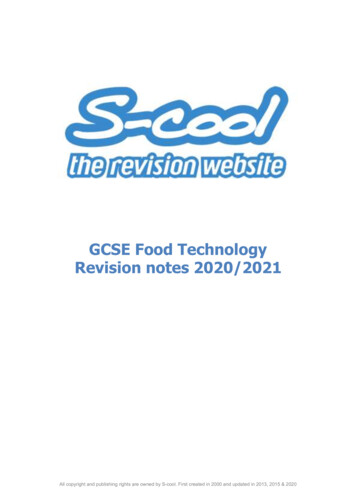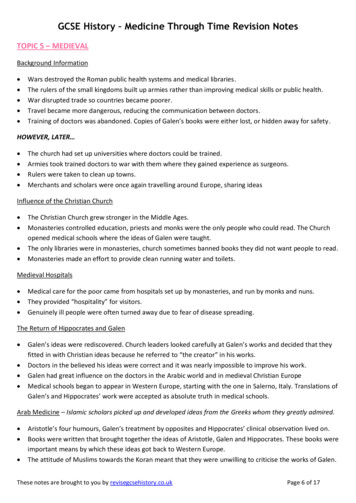
Transcription
GCSE Food TechnologyRevision notes 2020/2021All copyright and publishing rights are owned by S-cool. First created in 2000 and updated in 2013, 2015 & 2020
ContentsIngredients and Nutrition . 3Functions of ingredients . 3Nutrition . 4Packaging, Preserving and Food Poisoning . 7Food packaging . 7Preservation of food . 8Food poisoning . 11Systems and Control . 15Food Production Systems . 15Sensory Evaluation . 17Producing a New Product . 19Specifications . 19Development of a new product . 19Packaging and labelling of a food product . 20Risk assessment . 20These notes cover the main areas of this subject. Please check the specific areas you need with your examboard. They are provided “as is” and S-cool do not guaranteed the suitability, accuracy or completeness of thiscontent and S-cool will not be liable for any losses you may incur as a result of your use or non-use of thiscontent. By using these notes, you are accepting the standard terms and conditions of S-cool, as stated in the scool website (www.s-cool.co.uk).1All copyright and publishing rights are owned by S-cool. First created in 2000 and updated in 2013, 2015 & 2020
2All copyright and publishing rights are owned by S-cool. First created in 2000 and updated in 2013, 2015 & 2020
Ingredients and NutritionFunctions of ingredientsFlour: Provides fibre (especially if wholemeal) If Self-Raising, makes mixtures rise Thickens sauces Forms the bulk of bread, pastry and cake mixes If wholemeal, provides colour and texture Gluten in flour produces a stretchy dough Provides carbohydrate, Vitamin B, calcium and ironSugar: Provides sweetness If brown, provides colour and texture Large amounts prevent micro-organism growth (for example, jam/marmalade) Caramelises to produce a brown colour Retains moisture Helps to trap air in cake mixtures Provides carbohydrateEggs: Hold air when beaten Coagulate (sets) when heated Add colour to mixtures Thickens sauces, custards, etc. Glaze bread, scones and pastry Bind ingredients together Provide protein, fat, iron and Vitamins A, B, and EFats/Oils: Provide flavour Keep products moist and extend shelf-life Add colour to foods Make pastry 'short' by coating the flour to stop gluten developing Hold air when creamed with sugar Oil forms an emulsion with liquids (for example, mayonnaise) Provide energy and Vitamins A and D3All copyright and publishing rights are owned by S-cool. First created in 2000 and updated in 2013, 2015 & 2020
NutritionFats: Gives energy and vitamins A, D, E and K Found in oils, solid fats, fatty meat, cream, cheese and nuts Animal fats and some vegetables oils contain saturated fat, which may raise blood cholesterol levels Vegetable fats such as sunflower and soya and those in oily fish are polyunsaturated and better for the heart Gives a rich source of energy that can be converted into fat in the body, which protects organs and gives heatCarbohydrates: Provides energy and fibre Found in cereals, vegetables, sugar, rice, pasta, bread and pastries If the body receives more energy than it needs, it stores it as fat Wholemeal/wholegrain cereals are a richer source of fibre than white/refined ones Vitamins B and E, calcium and iron are also provided by breadProteins: Enables the body to grow and repair Found in milk, meat, fish, eggs and cheese Also in soya, beans, cereals, pulses and nuts If more protein is eaten than is needed for growth and repair, the excess is converted into glycogen in the liverand used as energy Animal foods and soya beans are used most efficiently by the body Many protein foods also provide iron and B vitamins (especially B12) Tofu (soya bean curd), Textured Vegetable Protein (TVP) made from soya flour, and Quorn (fungus) can all beused to replace animal proteinsVitamins: A: Fat-solubleHelps with night vision. Keeps the linings of the nose, throat and digestive system moist. Found as carotene inorange and red fruits and vegetables. Found as retinol in oily fish, liver, butter, margarine, cheese and eggs.Other sources include: mango, spinach, carrot, sweet potato. Excess may lead to liver damage. B: Water-solubleThiamin (B1), Riboflavin (B) and Niacin are involved in the release of energy from foods, healthy nervoussystem and skin. B12 helps prevent birth defects, such as Spina Bifida and is needed for red cell production.Found in marmite, meat, nuts, green leafy vegetables, yeast and dairy products. C: Water-soluble4All copyright and publishing rights are owned by S-cool. First created in 2000 and updated in 2013, 2015 & 2020
Needed for the formation and maintenance of connective tissue. Helps wounds to heal, helps prevent infectionsand aids iron absorption. Found in fruits and vegetables, especially citrus fruits, potatoes, broccoli, blackcurrantsand kiwi fruit. D: Fat-solubleProduced by the action of sunlight on the skin. Needed for the absorption of calcium in the bones and teeth.Found in butter, margarine, cereal, milk and fish. Excessive intakes can be dangerous. E: Fat-solubleMay be necessary for reproduction. Helps keep skin healthy. Found in eggs, wholegrain cereals, almonds,sunflower seeds, vegetable margarines and oils. K: Fat-solubleInvolved in the clotting of blood. Found in green vegetables, meat, beans, fruit and cereals.Minerals:Needed for: CalciumClotting of bloodFound in:Cheese, milk, bread, canned fish, green vegetablesStrong bones and teethHealthy muscles and nerves Healthy red blood cellsIronRed meat (especially liver), green vegetables, egg yolk,bread, fortified breakfast cerealsTransporting oxygen around thebodyVitamin C helps iron to beabsorbed by the body PhosphorusStrong bones and teethMilk, cheese, eggs, fish and nuts IodineHealthy thyroid glandSeafoods, vegetables, iodised saltHormone production SodiumCorrect concentration of bodilySalt, most ready-prepared foods, soya sauce, cheese,fluidsbaconHealthy nerves and musclesThe amount of nutrients required depends on 4 factors: Sex Age5All copyright and publishing rights are owned by S-cool. First created in 2000 and updated in 2013, 2015 & 2020
Activity Special conditionsMeasuring the amounts of nutrients needed. DRV (Dietary Reference Values): Estimates of the nutritional requirements of different groups of healthypeople of different ages. EARs (Estimated Average Requirements): Estimation of the needs of most people in a particular group. RDA (Recommended Daily Allowance): Often used on packaging to indicate whether or not a food productis a good source of a particular nutrient. RNI (Reference Nutrient Intake): Amount of a nutrient, which will satisfy 97.5% of the population in aparticular specified group.Healthy eating targets. 1: Energy obtained from total fat intake should be no more than 35% of the total energy intake. 2: The energy obtained from saturated fat should be reduced to 11%. 3: Obesity in people aged between 16-64 years should be reduced by a quarter in men and a third in women. 4: Blood pressure should be reduced by people cutting down on their intake of salt and alcohol.6All copyright and publishing rights are owned by S-cool. First created in 2000 and updated in 2013, 2015 & 2020
Packaging, Preserving and Food PoisoningFood packaging Gives food a longer shelf-life. Protects food during transportation and storage. Keeps food clean from dirt and bacteria. Provides information. Advertises the product. Holds the food in place.The following table is a list of the different packaging types and their advantages anddisadvantagesMaterial:Source: Advantages:Disadvantages:Used for:PaperWoodNot very strong.Flour, sugar,Can be waxed tomake it waterproof,loose fruiteasy to print on,andcheap, can eight, easilySoggy if wet.shaped, easy tocereals,print on, can becakes, fruitrecycled.juice.See-through, canCan break easily. OftenJam, wine,be coloured, cheap,needs a paper or plasticpickles, milk,can be recycled,film label. Heavy.cookingeasily moulded.MetalOresFrozen foods,sauces.Heat treated toCan rip (foil lids), oftenYoghurt lids,(Tinplate andpreserve theneeds a utensil to open it,tinned foods,aluminium)contents, can beneeds a paper label. Heatbottle tops.recycled, strong,treatment can alterlightweight.texture and taste.The UK Food Labelling Regulations 1996 state that the following information must be shown.7All copyright and publishing rights are owned by S-cool. First created in 2000 and updated in 2013, 2015 & 2020
1. Food Product Name. 2. List of ingredients. 3. Storage conditions. 4. Shelf life. 5. Instructions for use. 6. Name and address of manufacturer. 7. Place of origin. 8. Weight or volume.The following information is voluntary 1. A picture. 2. Recipe ideas. 3. Bar codes. 4. Environmental and recycling information. 5. Nutritional information. 6. Lot or batch mark. 7. Opening instructions. 8. Special information.Preservation of foodFood needs to be preserved. So that surplus foods from good harvests can be stored and then used in times of shortage. So that we can enjoy seasonal fruits and vegetables all year round. To enable it to be transported long distances without it decaying (and spillage!). To allow it to be stored in the home for long periods without going off.There are six main ways in which food can be preserved.1.High temperatures Canning Bottling Pasteurisation Ultra Heat Treatment (UHT) Sterilisation2.Low temperatures Freezing Chilling3.Removing moisture8All copyright and publishing rights are owned by S-cool. First created in 2000 and updated in 2013, 2015 & 2020
Drying Accelerated Freeze Drying (AFD)4.Use of chemicals Pickling Salting Smoking Sugar5.Controlling the atmosphere Vacuum Packing Modified Atmosphere Packaging (MAP)6.IrradiationMethods of preserving food.Method andAdvantages:Disadvantages:Used for:Canning:Lasts for manyCan causeFish, meat,Heat kills bacteriayears.changes in colourfruit,and texture. Lossvegetables,of Vitamin C.milk.How it works:and enzymes.Bottling:Lasts for manyCan causeFruit andHeat kills bacteriayears.changes in colourvegetables.and enzymes.and texture. Lossof Vitamin C.Pasteurisation:Little effect onNot all bacteriaMilk, cream,Most bacteriaflavour.killed.orange juice.UHT:Lasts forChanges tasteMilk, fruitAll bacteria killedseveralslightly.juices.killed at 72degrees Celsius.at 132 degrees9All copyright and publishing rights are owned by S-cool. First created in 2000 and updated in 2013, 2015 & 2020
Celsius.months.Sterilisation:Extends life ofGives a creamyFood is heated tomilk to aboutflavour and colour. juices.104 degrees10 days.Milk, fruitCelsius for 40minutes.Freezing:Foods can beSlow freezingReadyStops bacteria andfrozen forbreaks down cellspreparedenzymes activity.many months.and changes themeals, fish,Domestic freezersLittle loss oftexture of foods.meat,are at -18 degreesvitamins.vegetables,Celsius.fruit, icecreams.Chilling:Good colourTemperatures of 1and flavourShort storage life.preparedto 8 degreeskept.meals, suchCelsius slowReadyas Lasagne.bacteria growth.Drying:Last for longMost Vitamin CSoups, pasta,Removal ofperiods oflost. Must be keptbeans packetmoisture stopstime.dry.desserts.AFD:Good colourCan be expensive.Coffee.Food is frozen andand flavour.Very strongOnions,flavour.cabbage,bacteria growth.then dried quickly.Pickling:Increases acidityLong shelf life.of food.olives.10All copyright and publishing rights are owned by S-cool. First created in 2000 and updated in 2013, 2015 & 2020
Salting:Long shelf life.Food needs to beMeat, fish,Reduces watersoaked beforegreen beans.content bycooking.osmosis.Smoking:Adds flavour.Slow method,Kills Vitamins BBacon,and C.cheese, fish.which preventsbacteria growth.Sugar:Long shelf life.High temperatures Jams,More than 60%in jam making killmarmalade,will stop micro-Vitamin C.crystallisedorganism growth.fruits.Vacuum packs:RetainsOften still needsBacon, fish.Removes allvitamins.refrigerationMAP:Colour andExpensive.Replaces oxygenflavour areminced beef,with nitrogen andgood.and bacon.Irradiation:Delays ripening Not in generalStrawberries,Radiation kills,of fruit anduse. Consumervegetablessafety worries.and spices.oxygen.Meat, salads,carbon dioxide.bacteria and pests. sprouting ofvegetables.Food poisoning10 main causes of food poisoningCause:Prevention:11All copyright and publishing rights are owned by S-cool. First created in 2000 and updated in 2013, 2015 & 2020
Preparing food too far inPrepare food as close to consumptionadvance.as possible.Food cooled too slowly beforebeing refrigerated.Food must be refrigerated within oneand a half hours.Food not reheated enough toReheat food until it is piping hot all thekill bacteria.way through.Contaminated food eaten.Do not consume food after its eat-bydate, and store correctly.Food undercooked.Cook food thoroughly - use atemperature probe.Poultry not thawed properly.Make sure no ice crystals remain.Cooked food crosscontaminated by raw food.Use separate equipment for raw andcooked food.Hot food kept warm at less than63 degrees Celsius.Food handlers passing oninfection.Left-overs reheated.Check food with a temperature probe.Remove jewellery, wear aprons, washhands, report illnesses, etc.Use quickly, store below 5 degreesCelsius, reheat thoroughly.Micro-organismsThere are 3 types of micro-organism. Moulds12All copyright and publishing rights are owned by S-cool. First created in 2000 and updated in 2013, 2015 & 2020
Yeasts BacteriaThis table shows the most common types of food poisoning bacteria.Bacteria:Incubation: Symptoms: Found in:Importantpoints:Bacillus cereus 1-6 hoursCamploybacter 2-10 daysClostridiumbotulinum12-48hoursNausea,Cooked rice,Cool pasta andvomiting,diarrhoea.especially ifkept warm.rice quickly.Diarrhoea,abdominalMeat, shellfish, Most commonlymilk, untreated reported causepain.water.Paralysis.Can beCanned food, Rare form ofespecially dish, poisoning.fatal.meat andvegetables.of foodpoisoning.Bacteriaproduce spores,Water and soil. which Raw meat,Very commonperfringenshoursabdominalpain.cooked meatand products.cause ofpoisoning. MostSoil.active at 45-50degrees Celsius.Escherichia coli 1-2 days(E-Coli)Diarrhoea Raw meat,Drink bottledwith blood, untreated milk water whenvomitingListeriaUp to 70monocytogenes daysand dairyproducts.abroad.FluSoft cheesessymptoms, made withDangerous topregnantbloodpoisoning,women.unpasteurisedmilk, pate,meningitis. cook/chill13All copyright and publishing rights are owned by S-cool. First created in 2000 and updated in 2013, 2015 & 2020
foods.Salmonella12-48hoursDiarrhoea,fever,Meat, raweggs, cream,Babies, theelderly andvomiting,abdominalseafood.pregnantwomen shouldpain.not eat raweggs. Poultrymust bedefrosted wellbefore cooking.Staphyloccus1-8 hoursaureusVomiting,Meat and meat Personaldiarrhoea.products, eggs. hygiene is veryNose, throatimportant.and cuts offood handlers.EnzymesEnzymes can cause undesirable changes in foods that make them unsightly. This is called browning and iscaused by the action of an enzyme called polyphenol oxide in the presence of oxygen. Enzymatic browningcan be reduced by:1.High temperatures.2.Acidic conditions.3.Other methods.Symptoms of food poisoning1.Diarrhoea.2.Vomiting.3.Abdominal pain can be very unpleasant and can even cause hospitalisation, or death, for vulnerable groups suchas: Babies. Young children. The elderly. People whose immune systems are damaged.14All copyright and publishing rights are owned by S-cool. First created in 2000 and updated in 2013, 2015 & 2020
Systems and ControlFood Production SystemsA food production system has three parts1.Input: The different ingredients, materials, machinery and items which go into the system.2.Process: The different things that happen to the Input which change it into the Output.3.Output: The finished food product.This table shows you what precautions are taken during the food production process.Production:Raw materials must be of high quality.Storage:High-risk foods should be stored below 5 degrees CelsiusPreparation:Equipment and food handlers must comply with hygiene regulations.Cooking:Food must be cooked thoroughly to prevent food poisoning.Transportation: Temperature control may be necessary for high-risk foods.Serving:Food must be kept below 5 degrees Celsius or above 63 degrees Celsius.Hazard Analysis and Critical Control Point (HACCP)If a food manufacturer wishes to produce products which are of high and consistent quality s/he will need toidentify areas of production where inaccuracies (hazards) could occur. These inaccuracies are known as hazards.The food manufacturer must then design checks to be put into place to prevent hazards from occurring. H - Hazard A - Analysis C - Critical C - Control P - PointsA team of people will identify the hazards, which could be from micro-organisms, chemicals, people ormachinery.A CCP (Critical Control Point) could be any part of the production process, which could affect the finishedquality of the product. For example.15All copyright and publishing rights are owned by S-cool. First created in 2000 and updated in 2013, 2015 & 2020
Weighing of ingredients: Before and after preparation/cooking.Time:Of cooking, chilling, mixing, etc.Shaping:Of mixtures, division of dough, etc.Temperature:Storage of foods, cooking and chilling.Consistency of mixtures: During making and when cooked/chilled or stored.Hygiene:Of raw ingredients, food handlers, machinery and the finished dish.Each of the CCPs will have a tolerance level - for example, food could be cooked for between 20 and 22minutes. These may also be known as critical limits.Once these CCPs have been identified, checks can be put in place that will monitor a product's progress throughthe production process.These checks could be.1.Visual.2.Electronic.3.Scientific.Quality controlThis is the method used to check and test a product as it is made.When a product prototype gets into production, the following checks need to be made. Quality of ingredients. Working to designated tolerances (for instance, exact size/weight/viscosity/etc.). Size/thickness/quantity. Shape. Texture. Colour. Uniformity.You can show how quality control is achieved in your design folder by. Identifying the stages in the production of your food prototype.16All copyright and publishing rights are owned by S-cool. First created in 2000 and updated in 2013, 2015 & 2020
Using the list given above to prompt ideas for checks. Thinking about how you can carry out checks for quality at each stage. Describing the checks that you will make. Showing how you will correct problems after checks have been made.Standard food componentsThese are ready-prepared ingredients used during the manufacture of the food products.Advantages of using standard foodcomponents:1. Products are of a constant quality, size,shape and flavour.2. It saves time and therefore money.Disadvantages of using standard food components:1. Products must be available, in the right quality, whenever theyare required.2. Food producer has no input into the quality or production of thestandard food component.3. Prices may rise without warning.Sensory EvaluationThis process enables food manufacturers to find out what consumers think of their product and to ensure that allthe food produced by a production line is identical.The food will be tested using organoleptic factors, meaning that they are using our different senseorgans. Such as: Texture (mouthfeel) Taste or flavour Appearance or colour Smell or aromaIn order to ensure that sensory testing is considered to be 'fair', it is important that conditions arecarefully controlled. This will involve:1.Sipping water between each sample to remove the taste of the previous food.2.Using separate booths so that testers are not influence by each other.3.Labelling food with numbers or letters so that the tester does not recognise a brand name.4.Having a well-lit room with the minimum of noise and smells.5.Using clean cutlery and utensils for each sample.6.Sometimes using blindfolds (blind-testing) so that the tester is not influenced by the appearance of the food.7.Each sample of food being the same size.17All copyright and publishing rights are owned by S-cool. First created in 2000 and updated in 2013, 2015 & 2020
8.Having a minimum of 6 testers.Testers must not be: Suffering from a condition which would affect their taste (for example, smoking, a heavy cold, or taking strongmedication). Allergic to foods or ingredients.Different types of sensory tests1.Difference or Discrimination Tests.2.Grading Tests.3.Profiles.18All copyright and publishing rights are owned by S-cool. First created in 2000 and updated in 2013, 2015 & 2020
Producing a New ProductSpecificationsDesign specification: Written early on in the development of a product and is quite general and wide.Product specification: More detailed specification, usually written when the final product has been decidedupon.Manufacturing specification (Higher tier): Very detailed specification which would be given to the foodmanufacturer so that identical products can be produced on a large scale.How to design a manufacturing specification.Here are some ideas of what to include to produce a successful specifications. Specific dimensions (with a sketch). Specific qualities of ingredients. Names of ingredients with weights and proportions to use. Specific tolerances. The size to which ingredients must be cut. Types of cooking methods and cooking temperatures with critical control points. Cooling times and methods. Finishing techniques. Specific details of packaging requirements. Wording for the label. Sometimes a photograph is used to help a manufacturer to meet that specification.Development of a new productStages in product development:19All copyright and publishing rights are owned by S-cool. First created in 2000 and updated in 2013, 2015 & 2020
Packaging and labelling of a food productThere are loads of different techniques designers use to sell a product - from bright colours, to simplistic text depending on the age group of the people they're trying to attract. However, there are some limitations involvedin the design process: the material used for the packaging needs to be suitable for the food product it is holding.For example, if the product is a 'hand-held, take-away item', the packaging is likely to be. See-through so the consumer can quickly see what they are buying. Easy to remove. An insulator if the product needs to be kept hot (Polystyrene, for example). Grease and moisture resistant to keep hands clean. Easy to dispose of and recyclable, ideally.Suitable materials could be.Plastic:This is lightweight, moisture-resistant and see-through, but can be difficult to recycle.Polystyrene: This is lightweight, moisture-resistant and keeps food warm, but can be difficult to recycle.Paper:Cardboard:Lightweight, easy to recycle and print on, but not resistant to moisture or grease.Easy to print on, can be shaped to provide support, can be recycled, more moisture-resistant thanpaper.Take-away products will not always show details of ingredients, weight, storage details etc. However, if theproduct is sealed in a wrapper, it should show the following legally required information: Name and address of manufacturer/importer/retailer. List of ingredients in descending order of weight. Weight or quantity. Storage/cooking instructions An indication of when it should be consumed by (an 'eat-by', for instance). Name or description of the product.Risk assessmentRisk assessment means making an assessment of any risk to a food product during its production. Thisinvolves working out what chances there are of a food product being damaged or made incorrectly. Thinking about what could happen. Planning how to prevent it from happening.20All copyright and publishing rights are owned by S-cool. First created in 2000 and updated in 2013, 2015 & 2020
These regulations involve identifying the Critical Control Points (CCPs) which could be any part that couldaffect the finished quality of the product.For example: Weighing of ingredients. Time - chilling, cooking, setting. Shaping or division of dough. Temperature - in storage, cooking, etc. Consistency of mixtures. Hygiene - of equipment, ingredients and handlers.To establish a HACCP system for a product, a detailed analysis of the possible hazards needs to be undertaken.Critical Control Points can then be identified and appropriate control and monitoring systems put in place. Thesecould include. Thermometers on fridges/ovens. Timing devices on ovens/chilling units. Alarms which ring if any of these devices show a fault. Visual checks Micro-biological tests on food and equipment21All copyright and publishing rights are owned by S-cool. First created in 2000 and updated in 2013, 2015 & 2020
Terms and conditionsAll S-cool content (including these notes) belong to S-cool (S-cool Youth Marketing Limited).You may use these for your personal use on a computer screen, print pages on paper and store such pages inelectronic form on disk (but not on any server or other storage device connected to an external network) foryour own personal, educational, non-commercial purposes.You may not redistribute any of this Content or supply it to other people (including by using it as part of anylibrary, archive, intranet or similar service), remove the copyright or trade mark notice from any copies ormodify, reproduce or in any way commercially exploit any of the Content.All copyright and publishing rights are owned by S-cool. First created in 2000 and updated in 2013, 2015 &2020.22All copyright and publishing rights are owned by S-cool. First created in 2000 and updated in 2013, 2015 & 2020
4 Nutrition Fats: Gives energy and vitamins A, D, E and K Found in oils, solid fats, fatty meat, cream, cheese and nuts Animal fats and some vegetables oils contain saturated fat, which may raise blood cholesterol levels Vegetable fats such as sunflower and soya and those in oily fish are polyunsaturated and better for the heart Gives a rich source of energy that can be converted into fat in .











